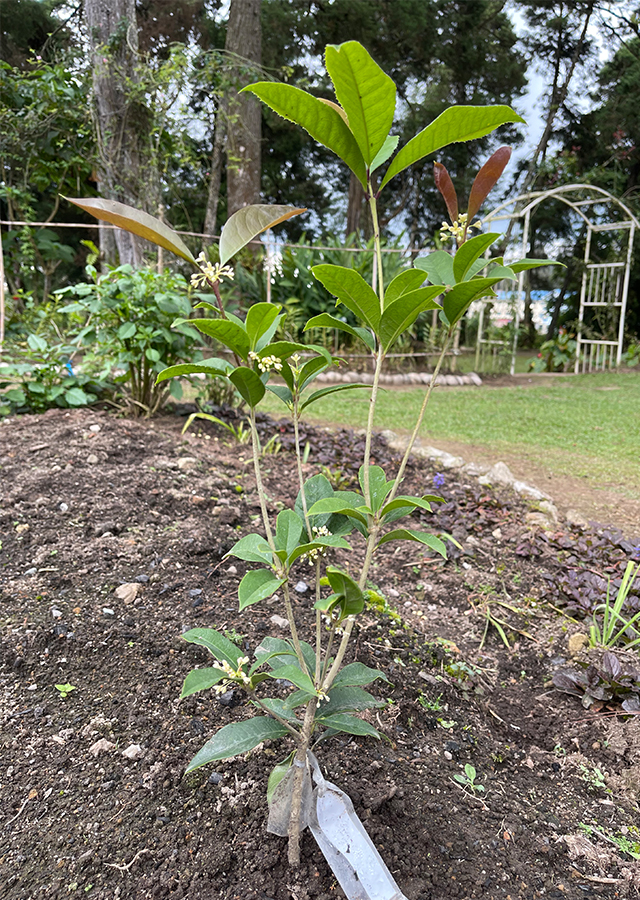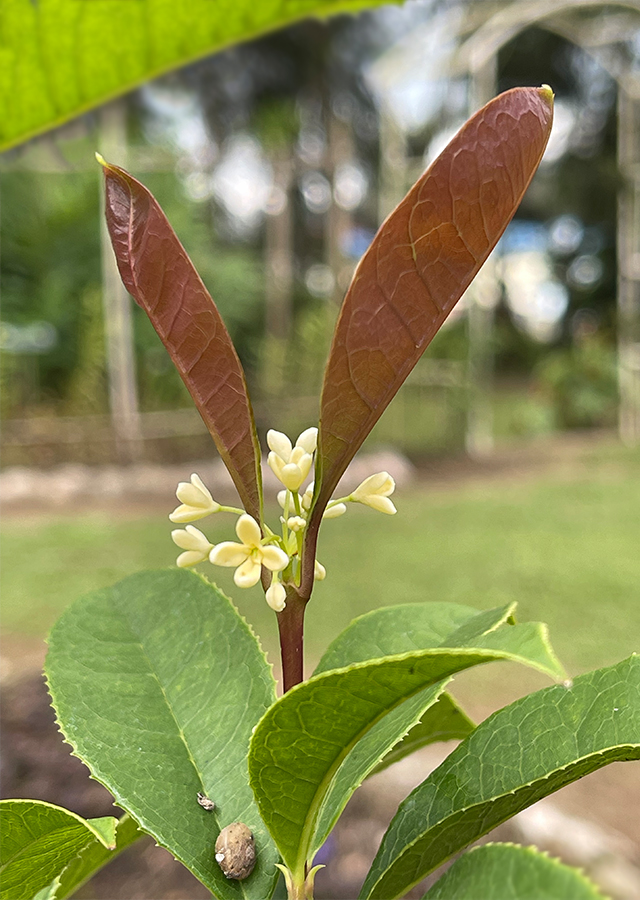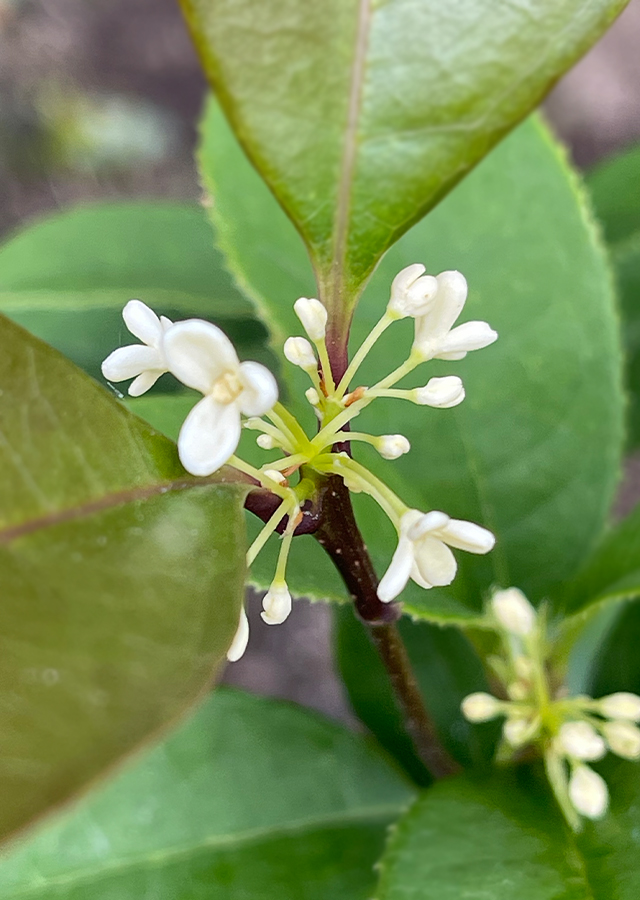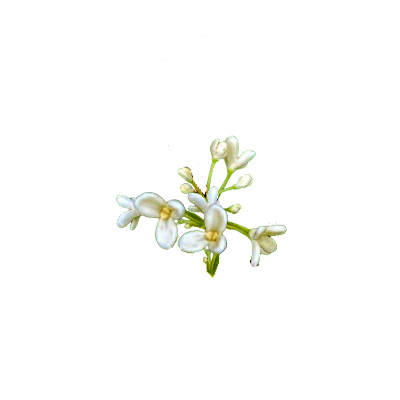Sweet Olive
Osmanthus fragrans Lour.
Oleaceae
Location in our garden
Principal



Synonym
Osmanthus acuminatus (Wall. ex G.Don) Nakai
Osmanthus asiaticus Nakai
Osmanthus aurantiacus (Makino) Nakai
Habitus
Shrubs. An evergreen perennial shrub growing around 6-15 m tall.
Part Used
Bark
Flowers
Roots
Stem
Growing Requirements
Full Sunshine
Need Shade
Habitat
Forest
Mountains
Overview
Osmanthus fragrans is native to Asia. The scientific name comes from the Greek words for fragrant (osme) and flower (anthos). The very fragrant flowers (apricot scent) are used by the Chinese to impart a pleasant aroma to tea, wine and sweet dishes such as lotus seed soup, pastries and steamed pears. They are also added to herbal medicines in order to disguise obnoxious flavours. Extracts from the flower are highly valuable, and are used in some of the most expensive perfumes.
Vernacular Names
Mu xi (Chinese)
Agroecology
Can be found on mountain and forest at elevations of 1,300 - 3,000 m. Easily grown in any well-drained soil in sun or part shade, but flowering more freely in a sunny position. Thrives in chalky conditions. Dislikes unduly exposed position, and requires shelter from freezing winds.
Morphology
- Stem - woody upright
- Leaves - simple, 7 – 15 cm long, and 2,5 – 6 cm wide, glabrous and elliptic to elliptic-lanceolate in shape and are arranged in opposite pairs along the stem. Petiole 0.8-1.2 (-1.5) cm; base cuneate or broadly cuneate, margin entire or usually serrulate along distal half, apex acuminate; midrib and 6-8(-10) primary veins adaxially impressed and abaxially raised. Cymes fascicled in leaf axils
- Flowers - small, corolla yellowish, yellow, or orange, 3-4 mm; tube 0.5-1 mm. Stamens attached to middle of corolla tube; connective elongated into an obscure mucro, clustered in the leaf axils and have a very strong fragrance of ripe apricots.
- Fruit - drupe purple-black, ellipsoid, oblique, simple, fleshy, 10 – 15 mm long.
Cultivation
- Generative propaation is by seed - best sown as soon as it is ripe in a coldframe. Stored seed probably germinates best if it is given 3 months warm then 3 months cold stratification before sowing. The seed usually takes 6 - 18 months to germinate, it should be pricked out into individual pots when it is large enough to handle. Grow the plants on for their first winter in the greenhouse and plant them out in early summer.
- Vegetative propagation is by cuttings and layering.
- Cuttings: 1.) Cuttings of half-ripe wood taken at the end of July, in a frame with bottom heat. 2.) Cuttings of almost ripe wood, 7 - 12cm with a heel. Plant out in the spring 18 months later.
Chemical Constituents
Essential oil (ionone), ionol, flavonoids, polyphenols, iridoids, linalool, and limonene.
Traditional Medicinal Uses
- Pharmacological studies demonstrated wide range of biological activities, such as antioxidant, antitumor, anti-inflammatory, anti-hyperglycemic, anti-thrombotic, anti-melanogenesis, neuroprotective, and hepatoprotective activities, etc.
- It has been used traditionally for the treatment of weakened vision, halitosis, panting, asthma, cough, toothache, stomachache, diarrhea, rheumatism, physique pain and hepatitis.
- A decoction of the stem bark is used in the treatment of boils, carbuncles etc.
- A paste made from the stem or bark is used in the treatment of boils, carbuncles, whooping cough and retinitis..
- A decoction of the lateral roots is used in the treatment of dysmenorrhoea, rheumatism, bruises etc
- The flowers are antitussive.
Part Used
Reference Sources
- Fern, Ken. (2024). Useful Tropical Plants: Osmanthus fragrans. https://tropical.theferns.info/viewtropical.php?id=Osmanthus+fragrans. 01-03-2024.
- Flora Fauna Web. (2021). Osmanthus fragrans Lour.NParks | Osmanthus fragrans. 01-03-2024.
- Flora of China. (No date). . http://www.efloras.org/florataxon.aspx?flora_id=2&taxon_id=210001392. 01-03-2024.
- NC Cooperative Extension. (No date). North Carolina Extension Gardener Plant Toolbox: Osmanthus fragrans. https://plants.ces.ncsu.edu/plants/osmanthus-fragrans/. 01-03-2024.
- Royal Botanic Gardens. Kew. (No date). Plants of the World Online: Osmanthus fragrans Lour. https://www.missouribotanicalgarden.org/PlantFinder/PlantFinderDetails.aspx?kempercode=a886. 01-03-2024.
- Wang, Baojun, and Luan, Fei, et al. (2022). Traditional uses, phytochemical constituents and pharmacological properties of Osmanthus fragrans: A review. Ethnopharmacol, 15:293:115273.doi: 10.1016/j.jep.2022.115273.



